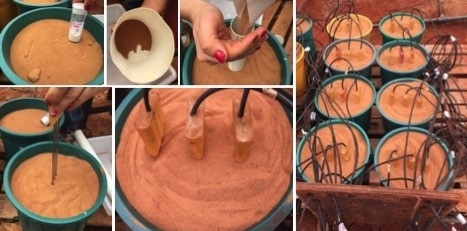


The strategy was tested at the Federal University of São Carlos and found to permit a reduction in the amount of fertilizer used by farmers, mitigating its environmental impact (analyzing soil samples; credit: researchers’ archive)
Published on 03/14/2022
By José Tadeu Arantes | Agência FAPESP – One of the worst environmental problems at present is due to excess fertilizers, pesticides and growth regulators left in the soil by agriculture, especially on large farms. In many cases, these agrochemicals can be replaced by environmentally safe and sustainable alternatives. Moreover, they are typically applied in far larger amounts than necessary to offset potential losses due to volatilization, solubilization and leaching into the ground.
In the specific case of fertilizers, one way to reduce the amount of material used, enhance its efficiency and minimize its environmental impact is to encapsulate the nutrients in biodegradable coatings that assure their gradual controlled release into water or soil.
Research focusing on the development of materials for fertilizer encapsulation has been conducted since 2014 by scientists at the Federal University of São Carlos (UFSCar) in Araras, São Paulo state, Brazil.
An article about some of the research is published in the journal Carbohydrate Polymers.
The study reported in the article was supported by FAPESP via a Regular Research Grant awarded to the principal investigator, Roselena Faez, and a doctoral scholarship awarded to the second author, Débora França.
“Fertilizers are made up of highly soluble salts and easily washed away by rain. Encapsulation enables them to be gradually released in a controlled manner so as to reduce the amount used and minimize waste,” Faez told Agência FAPESP.
Enhanced efficiency
According to Faez, solving the question of encapsulation is an indispensable step in obtaining enhanced efficiency fertilizers (EEFs), which presuppose the adjustment of several parameters, such as nutrient release and absorption by crops, biodegradability of the coating material, and the cost-effectiveness of the end-products. “To arrive at the right coating material, we began with chitosan, a bio-based polymer that’s abundant, renewable and easy to obtain,” she said.
Chitosan is produced by treating chitin with an alkaline substance such as sodium hydroxide. Chitin is a polysaccharide present in the shells of lobsters, crabs and other crustaceans, as well as the exoskeletons of insects and the cell walls of fungi.
“Chitosan has very good mechanical properties and is capable of forming gels, fibers, films and microspheres, making a wide array of applications possible,” Faez said. “It’s extremely attractive thanks to its biocompatibility, biodegradability and non-toxicity.”
Faez and collaborators prepared chitosan microspheres and microcapsules to coat fertilizer. “In previous research, conducted in partnership with Professor Claudinei Fonseca Souza at UFSCar Araras, we had already used a technique to monitor nutrient release from fertilizer into the soil without needing to collect samples,” Faez explained. “This is done by measuring the electrical conductivity of the soil and correlating it with nutrient release.”
In their latest study, the group analyzed nutrient release and biodegradation to see whether the latter begins during the former. “Our results are without precedent in the literature,” Faez said. “We found that nutrient release correlates both with diffusion – the influx of water and efflux of nutrients – and matrix biodegradation. We observed that during the first 30 days release linked to swelling and diffusion occurred concomitantly with biodegradation. After 40 days, all nutrients had been released and biodegradation occurred only in the matrix.”
After publication of the article, the group continued their research to investigate how the types, effects and quantity of nutrients influenced biodegradation. “We’re working with essential macronutrients – potassium, nitrogen and phosphorus – as well as micronutrients, such as copper, manganese, iron and so on, to evaluate the soil’s microbiological system during and after biodegradation of the polymer,” Faez said.
The article “Biodegradation and viability of chitosan-based microencapsulated fertilizers” is at: www.sciencedirect.com/science/article/abs/pii/S0144861721000230.
The article “A review of advances over 20 years on polysaccharide-based polymers applied as enhanced efficiency fertilizers” by Faez and collaborators is at: www.sciencedirect.com/science/article/abs/pii/S0144861721014016.
Source: https://agencia.fapesp.br/38133